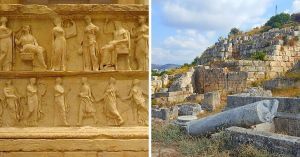Quest for the Phoenicians
National Geographic
Because the Phoenicians were a sea-based culture, archeologists typically study shipwrecks to learn bout their history. Gorem’s Cave in Gibraltar is also a significant source of Phoenician artifacts, including personal charms, scarabs, glass vases.* With the advent of DNA sequencing, this has been a new source of knowledge about their origins and history.
As the Phoenicians left no written manuscripts, most of what we know of them is from Greek and Roman historians. According to Herodotus, Sidon in modern day Lebanon was the Phoenicians’ original homeland, First appearing around 1200 BC, they later settled Carthage in North Africa. With total control over Mediterranean sea trade for 1,000 years, the Phoenicians, operating out of Tyre (Lebanon), were the first international cartel. They also had formidable warships, with a massive intimidating harbor in Carthage.
They built their ships out of the famous cedars of Lebanon, as well as transporting cedar logs to Egypt for the pharaoh’s palaces to Israel for King Solomon’s temple. Discoveries from sunken Phoenician ships reveal they also traded in ostrich eggs (from Africa) a valuable purple dye used Egyptian, Greek and Roman and amber (prized fossilized tree resin).
Statues found at the ancient Temple of Eshman near Sidon suggest their artistic taste mimicked that of their Egyptian, Persian and Israeli trade partners.
 Jezebel from the Old Testament was a Phoenician princess who seduced Ahab, the king of Israel, and persuaded him to worship Baal, an ancient Canaanite fertility and storm god.
Jezebel from the Old Testament was a Phoenician princess who seduced Ahab, the king of Israel, and persuaded him to worship Baal, an ancient Canaanite fertility and storm god.
Excavation of Phoenician ruins in Sidon has only begun recently owing to Lebanon’s decades long civil war. Tabnit was the Phoenician King of Sidon* from 549–539 BC. He was mummified and buried in a borrowed Egyptian sarcophagus. His DNA is being studied to determine if the Phoenicians were related to 1) Canaanites described in the Bible and 2) modern Lebanese populations. The Canaanites inhabited the Levant from 2000-1200 BC. According to Egyptian legend, “Sea Peoples” invaded the Levant around 1200 BC. Some historians believe they intermarried with the Canaanites and their offspring were the first Phoenicians.
Rome’s war on Carthage (referred to a the Punic Wars) lasted 100 years. Rome was eventually victorious in 146 BC (see How Senate Corruption Caused the Demise of the Roman Republic). The strain of the Punic wars led to civil war in Rome and (when Julius Caesar became emperor in 100BC) the end of the Roman republic.
In Carthage in modern day Tunisia only 20% of the population carry genetic markers for Phoenician ancestry. Archeologists believe either the Romans either wiped them out or that the Phoenicians ruled an indigenous population there without intermarrying or encouraging settlement by Phoenician settlers.
From the limited evidence available, Phoenicians seem to have been genetically identical to the Canaanites.
*It’s believed these artifacts are offerings to the gods for safe passage through the turbulent Straits of Gibraltar.
The Most Revolutionary Act
- Stuart Jeanne Bramhall's profile
- 11 followers



